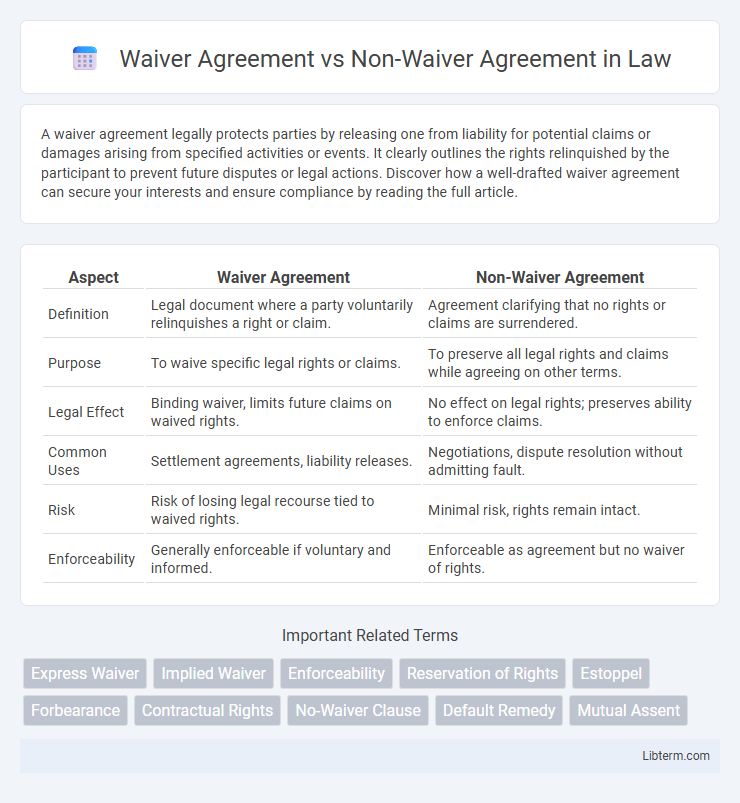A waiver agreement legally protects parties by releasing one from liability for potential claims or damages arising from specified activities or events. It clearly outlines the rights relinquished by the participant to prevent future disputes or legal actions. Discover how a well-drafted waiver agreement can secure your interests and ensure compliance by reading the full article.
Table of Comparison
| Aspect | Waiver Agreement | Non-Waiver Agreement |
|---|---|---|
| Definition | Legal document where a party voluntarily relinquishes a right or claim. | Agreement clarifying that no rights or claims are surrendered. |
| Purpose | To waive specific legal rights or claims. | To preserve all legal rights and claims while agreeing on other terms. |
| Legal Effect | Binding waiver, limits future claims on waived rights. | No effect on legal rights; preserves ability to enforce claims. |
| Common Uses | Settlement agreements, liability releases. | Negotiations, dispute resolution without admitting fault. |
| Risk | Risk of losing legal recourse tied to waived rights. | Minimal risk, rights remain intact. |
| Enforceability | Generally enforceable if voluntary and informed. | Enforceable as agreement but no waiver of rights. |
Understanding Waiver Agreements
Waiver agreements involve a party voluntarily relinquishing a known right or claim, often to avoid future disputes or liabilities, making them critical in contract and legal contexts. Understanding waiver agreements requires recognizing their role in preventing parties from asserting rights or claims after agreeing to waive them, effectively limiting legal recourse. These agreements must be clear, specific, and voluntarily executed to be enforceable, distinguishing them sharply from non-waiver agreements, which preserve rights despite certain actions or inactions.
What is a Non-Waiver Agreement?
A Non-Waiver Agreement is a legal contract that ensures a party's rights or claims are preserved even when they do not immediately enforce them. This agreement prevents the unintentional relinquishment of rights by clarifying that a failure to act or delay in enforcement does not constitute a waiver. It is commonly used in commercial contracts to maintain all parties' protections without forcing immediate action.
Key Differences Between Waiver and Non-Waiver Agreements
A Waiver Agreement explicitly relinquishes a party's right to enforce certain contractual provisions, often used to prevent future claims based on past breaches. In contrast, a Non-Waiver Agreement ensures that a party's rights remain intact despite temporary forbearance or leniency, preserving the ability to enforce terms later. The key difference lies in the intent and legal effect: Waivers extinguish rights while Non-Waivers maintain them despite any temporary non-enforcement.
Legal Implications of Waiver Agreements
Waiver agreements have significant legal implications as they involve a party voluntarily relinquishing a known right, claim, or privilege, potentially limiting future legal recourse. Courts generally enforce clear and unambiguous waiver agreements, but ambiguous language or coercion can render them invalid. Understanding the precise scope and enforceability of waiver provisions is crucial for mitigating legal risks and ensuring contractual obligations are properly managed.
Benefits of Using Waiver Agreements
Waiver agreements provide clear legal protection by explicitly relinquishing a party's right to make claims or enforce certain rights, reducing the risk of future litigation. They establish mutual understanding and consent, which can help in avoiding disputes and fostering trust between parties. Using waiver agreements can also simplify transaction processes and limit liability, offering a streamlined and predictable resolution framework.
Risks Associated with Non-Waiver Agreements
Non-waiver agreements involve significant risks as they may lead to unintended acceptance of liability or claims, complicating dispute resolution processes. Parties must clearly define the scope and intent to avoid waiving rights unknowingly, which can result in loss of legal protections. Failure to properly manage non-waiver clauses increases exposure to contractual breaches and potential financial damages.
Common Situations for Waivers and Non-Waivers
Waiver agreements commonly arise in situations such as event participation, where individuals relinquish rights to hold organizers liable for injuries, or in contract disputes where parties voluntarily forgo specific claims to maintain the agreement. Non-waiver agreements typically occur in insurance and commercial contracts, preventing parties from unintentionally waiving rights or defenses during negotiations or partial performance. These agreements are critical in maintaining legal protections while allowing ongoing discussions or provisional actions without compromising contractual entitlements.
Drafting an Effective Waiver Agreement
Drafting an effective waiver agreement requires clear and specific language that precisely identifies the rights being waived and the scope of the waiver to prevent future disputes. It is essential to include detailed descriptions of the risks involved, parties' consent, and any limitations on liability to ensure enforceability under applicable law. Proper incorporation of governing law clauses and explicit statements about the waiver's voluntary nature enhances the legal strength and clarity of the waiver agreement.
Enforceability of Waiver vs Non-Waiver Agreements
Waiver agreements are generally enforceable when they clearly specify the rights being waived and are entered into voluntarily with informed consent, often limiting liability or claims in contractual relationships. Non-waiver agreements, by contrast, preserve existing rights and do not relinquish legal claims, maintaining enforceability by explicitly stating that no waiver of rights occurs despite certain actions or delays. Courts tend to enforce waiver agreements when fairness and clarity exist but uphold non-waiver agreements to ensure parties retain their rights, emphasizing the importance of precise language in both for legal certainty.
Choosing the Right Agreement for Your Needs
Choosing the right agreement depends on your intention to either relinquish or preserve legal rights in specific situations. A Waiver Agreement explicitly surrenders claims or rights, providing clear protection against future liability, ideal for risk transfer in contracts or events. Conversely, a Non-Waiver Agreement maintains all parties' rights while allowing negotiations or temporary actions without admitting fault, crucial for preserving legal options during dispute resolution or contract modifications.
Waiver Agreement Infographic

 libterm.com
libterm.com